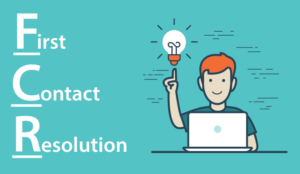Dick Bourke of Scorebuddy introduces us to First Call Resolution (FCR), taking us through how to measure the metric and improve it.
For one-third of your customers, you have just one chance to make a positive impression, or they’ll switch companies – according to American Express.
So, it should be no surprise that FCR is one of the most important metrics your contact centre can measure.
If your contact centre team fails at providing a positive customer experience on the first call, they may not get a second chance. It’s that simple.
The problem is that few call centres are talking about first call resolution. FCR is essential to customer satisfaction, and by focusing on it, you can completely change the way your team handles customers for the better.
But first, you need to understand FCR.
What Is First Call Resolution?
FCR is almost exactly what it sounds like. It’s how you handle a customer’s issues during first contact. This can mean anything from resolving problems during a phone call, first email, single social media contact, or live chat support. The goal is to eliminate the need for your customer to follow up with a second call.
The problem is the subjective nature of first call resolution. You need a way to determine that the customer left the interaction satisfied, happy, and with an overall positive customer experience.
To do this, it can be best to track your first interaction with some type of scorecard or customer service survey, which is then how you can calculate your FCR rate.
Calculating Your First Call Resolution Rate
First call resolution rate is a simple formula that provides a metric essential to your success. To calculate it, you simply divide the number of support issues resolved during your first contact by the total number of FCR-eligible issues.
FCR Rate (%) = Total number of resolved support issues on first contact/ Total number of eligible support issues X 100
The key word is eligibility. You should not include issues that would be impossible to resolve on first contact. For example, if the customer told you the incorrect problem over the phone or through email.
It’s also essential that you define exactly what you mean by “first call” and “resolution”:
- Do you still consider it a first call if you have to escalate the interaction to a manager?
- What does it mean to be resolved?
- Does the customer have to explicitly state you’ve resolved their problem?
- Do they need to achieve a certain score on your scorecard?
- Does the customer have to avoid contacting you again for a certain length of time?
The good news is that tracking FCR rate is well worth the effort.
First Call Resolution and Customer Experience
67 percent of customer churn is preventable if firms resolve issues the first time they occur, according to Ameyo.
In addition, the SQM Group reveals that for every 1% improvement in FCR, a contact centre reduces operating costs by 1% and improves customer satisfaction by 1%. They also revealed that customer satisfaction drops by 15% every time a customer has to call back about the same issue.
It’s simple. The higher your FCR rate, the more positive your customer experience. And, as customer sentiment improves, the higher your customers’ lifetime value (CLTV).
In fact, according to SQM’s research, every time a customer’s call is resolved, you increase your customer cross-selling acceptance rate by up to 20%.
Another important metric to measure is your CSAT rating from a holistic perspective, identifying the relationship between FCR and NPS. If FCR is on the rise, this should reflect in other areas of the business.
FCR rate is also a valuable metric for determining whether or not your customer service agents enjoy what they do.
According to Harris Interactive, friendly customer service representatives are what make a memorable experience that causes 73% of consumers to stick with a brand.
The idea is that if you can resolve your customers’ issues in a single interaction, you make their lives easier because they don’t have to follow up. This is the most important factor in building customer loyalty, according to a Harvard Business Review study.
5 Steps to Improve Your First Call Resolution Rate
First call resolution makes your customers happy, makes your team more efficient, and saves your business time and money. So, how do you improve it?
1. Assess Your FCR
The first step is to understand where you are right now:
- What is your current FCR rate?
- What issues are coming up most often that are causing your customers to reach out?
- What are the leading causes of delayed resolution—tech troubles, confusing instructions, price concerns, etc.?
- What platforms are you using to help measure your FCR rate and the overall customer experience?
The more you know about your current customer service situation, the better you’ll be able to improve call centre management and enhance your FCR rate. It’s all connected.
Low FCRs don’t happen in a vacuum. You need to be able to identify your weak points if you want to improve.
2. Set Your Priorities
You also need to ensure that the quality of your first interaction with every customer should take priority over other metrics such as time on call. This requires developing a FCR plan.
It should consider every initial point of contact, and be a cross-channel strategy that helps customers no matter when or how they reach out. The key is to make FCR a long-term policy that drives all your customer service interactions.
3. Empower and Educate Your Agents
Empower your agents to improve FCR by giving them a budget and the education required to handle problems. Your agents should have the tools, training, and processes required to resolve customer issues on their own initiative.
Your goal should be to avoid transfers whenever and wherever possible. Giving your agents more ownership incentivises them to reduce callbacks.
As for training, prioritise what makes sense for the most common issues your customers face. For example, you should emphasise in-depth product knowledge, but also offer cross-training so that all of your agents are prepared to deal with more complex issues.
Regular training along with micro-coaching sessions ensures that everyone is on the same page and prepared to handle every issue.
4. Operate Strategically
To improve FCR rate, you need to adjust your operation to perform more strategically when it comes to your customers. This can mean everything from making sure the right customer gets to the right agent.
These considerations include: demographics, purchase history, personas, to learning how to break down interactions to the root cause for the contact.
Don’t look at your contact centre as a silo. Instead, create a system that allows your agents to utilise other departments and employees, so they can directly solve issues in real time.
By creating this collaborative environment, you also ensure that agents are better able to anticipate future enquiries based on data and insights from all areas of your business.
5. Measure Your Progress
Finally, measure your progress and touch base with your customers on a regular basis. See what you can do to continue to improve your FCR rate. The more you know about what’s working, common customer issues, and how your agents feel, the more proactive you can be.

Dick Bourke
FCR needs to be a priority for your company, and particularly for your call centre. The more unresolved issues you have, the more money you’re leaving on the table, and the more long-term customers you’ll lose.
Instead, by investing in FCR, not only will you improve the overall customer experience, you’ll increase customer loyalty, increase your revenue, and improve your customer lifetime value.
This blog post has been re-published by kind permission of Scorebuddy – View the Original Article
For more information about Scorebuddy - visit the Scorebuddy Website
Call Centre Helper is not responsible for the content of these guest blog posts. The opinions expressed in this article are those of the author, and do not necessarily reflect those of Call Centre Helper.
Author: Scorebuddy
Published On: 22nd May 2019 - Last modified: 11th May 2021
Read more about - Guest Blogs, Scorebuddy






 Scorebuddy is quality assurance solution for scoring customer service calls, emails and web chat. It is a dedicated, stand-alone staff scoring system based in the cloud, requiring no integration.
Scorebuddy is quality assurance solution for scoring customer service calls, emails and web chat. It is a dedicated, stand-alone staff scoring system based in the cloud, requiring no integration. 









